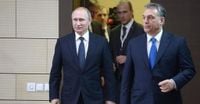Russian aerial provocations and hybrid threats have escalated sharply across Europe in recent weeks, rattling NATO members and exposing new fissures in the continent’s political and security fabric. From brazen airspace violations over Estonia to suspected sabotage at airports in Denmark and Poland, the Kremlin’s campaign of pressure and intimidation is entering a more dangerous phase, prompting forceful rhetoric—and some surprising policy shifts—from leaders as far-flung as Budapest and Washington.
According to reporting from multiple sources, the last several weeks leading up to October 2, 2025, have witnessed a series of Russian incursions into NATO airspace, including a particularly alarming incident involving three Russian fighters violating Estonian territory. These transgressions were not isolated: airports in Denmark and Poland experienced disruptions widely attributed to Moscow’s handiwork, while drone sightings—believed to be of Russian origin—were reported over Denmark, Norway, and Poland throughout September. The incidents have triggered a furious debate among Western analysts and policymakers about President Vladimir Putin’s intentions and the appropriate response.
The gravity of the situation became clear when Denmark, feeling the heat of these suspected operations, called up hundreds of reservists in a stark demonstration of readiness. NATO, for its part, issued a promise of a “robust response,” signaling that the alliance would not tolerate further provocations. Meanwhile, the rhetoric ratcheted up on both sides of the Atlantic. On October 2, 2025, former President Donald Trump endorsed the idea that NATO allies should shoot down any Russian fighter jets that violate their airspace—a stance that, while controversial, found some resonance among Eastern European leaders wary of Moscow’s intentions. Russia, never one to back down from a challenge, countered with a warning that any such aggression would be met with its own “decisive response,” raising the specter of a dangerous tit-for-tat escalation.
The Kremlin’s strategy, as noted by several analysts and echoed in Western media, is hardly new. For more than two decades, Russia has pursued a campaign of clandestine sabotage, including the bombing of arms production and storage facilities and the deliberate severing of undersea cables. The pattern is clear: by sowing divisions and exploiting weaknesses within NATO and the EU, Russia aims to undermine international support for Ukraine and destabilize the political order in Europe. As one commentator put it, each incursion is a calculated taunt; any equivocation or internal dissension among NATO members is a propaganda victory for Putin, while overly aggressive responses risk playing into his hands and escalating the conflict further.
Amid this tense backdrop, Hungarian Prime Minister Viktor Orbán made headlines with a dramatic policy shift. On October 2, Orbán declared that Hungary would shoot down any Russian drones violating its airspace, a far harder stance than his government has shown before. “As far as I know, yes. We are not afraid of it, and of course we will shoot them down,” Orbán stated, according to Danish media. This move marks a significant departure from Hungary’s traditionally more conciliatory approach toward Moscow and signals a willingness to assert national sovereignty even at the risk of irritating both Russia and Western allies.
Orbán did not stop there. He openly criticized Western Europe for acting weak despite, in his words, being “stronger in all aspects” compared to Russia. “I have never understood why, being stronger, we talk as if we are weak. Russia is weak compared to us, weak militarily, economically and also numerically,” Orbán insisted. These remarks challenge the prevailing political tone in many EU capitals, where caution and consensus-building often dominate the response to Russian provocations.
The Hungarian leader’s newfound assertiveness comes at a delicate moment. Ukraine’s President Volodymyr Zelensky recently reported that reconnaissance drones, possibly Hungarian, may have crossed into Ukrainian territory. The alleged violations sparked cross-border tension, with Kyiv preparing a military response should such incursions happen again. Hungary’s Foreign Minister initially dismissed the accusations as lies, but Orbán later conceded that drones might have “flown a few metres over the border,” downplaying the significance of these minor incursions. This reversal has fueled questions about Hungary’s role on the border and its balancing act between East and West.
Orbán’s government has long maintained friendlier ties with Moscow than most EU or NATO members, frequently criticizing EU sanctions and promoting a nationalist, non-aligned foreign policy. Yet, by threatening to shoot down Russian drones, Orbán is signaling a more independent and assertive foreign policy—even if it risks straining relations with both Russia and his Western partners. Hungary’s pivot underscores the growing complexity of alliance politics in the face of Russian hybrid warfare.
Elsewhere in Europe, the response to Russian drone incursions has been mixed. Some countries have shot down these drones, while others have refrained, underscoring the lack of a unified approach to hybrid threats. The incidents have raised alarms about the growing sophistication and frequency of such attacks, prompting EU defense ministers to discuss a coordinated “drone wall” across exposed borders. This proposed defense line would include radars, jammers, and rapid-response systems to detect and neutralize drone threats, covering nations like Denmark, Poland, Norway, and Romania. The idea is to create a shared European shield against a threat that respects no border or alliance.
Hybrid threats are not limited to the air. On Russian state-controlled television, loyal to President Putin, commentators recently floated the idea of detonating the SS Richard Montgomery, a Second World War wreck in the River Thames estuary that still holds 1,400 tonnes of munitions. Kremlin-aligned historian Dr. Andrey Sidorov called for a covert strike on the ship as “revenge” for Britain’s alleged role in Ukraine’s recent campaign against Kremlin oil refineries. The suggestion, made during a late-night propaganda broadcast, was chilling in its audacity. While British authorities consider the risk of detonation “remote”—the wreck lies in a restricted zone and is constantly monitored—a government study from 2001 warned that a full blast could cause up to £1 billion in damage and generate a one-metre wave impacting the Kent and Essex coastlines. Sidorov argued, “If you hit it, this will flood all the coastal villages and ports. So we need to start with that, right today.”
The rhetoric on Russian television has not been limited to the UK. Notorious TV host Vladimir Solovyov urged Moscow to strike Europe’s key oil hub in the Netherlands in retaliation for Ukrainian attacks on Russian refineries, declaring, “The oil refineries in the Netherlands must burn. They must all be destroyed. Everything they have must burn.” Meanwhile, Kyiv’s military leaders have unveiled a cruise missile capable of striking 1,800 miles into Russia, raising the stakes even further in this shadowy conflict.
As Europe grapples with this new wave of hybrid threats, the choices facing its leaders are stark. Aggressive responses risk escalation, while indecision or division only embolden the Kremlin. The continent’s security now hinges not just on military might, but on unity, resilience, and the ability to adapt to a conflict that is as much about psychology and politics as it is about bombs and drones.
For now, each incursion, each threat, and each rhetorical flourish is another move in a high-stakes game that shows no signs of ending soon.




